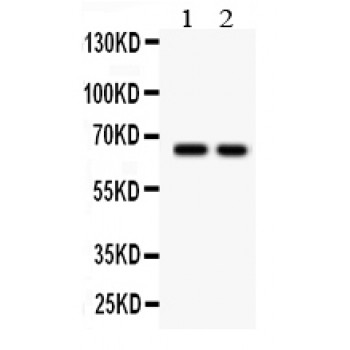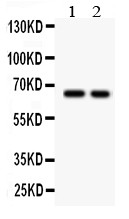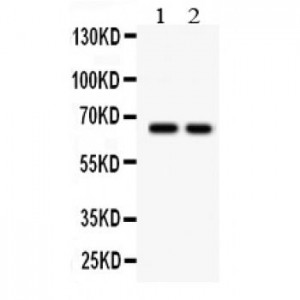More info
Overview
Long Name | Antibody Type | Antibody Isotype | Host | Species Reactivity | Validated Applications | Purification |
| transforming growth factor, beta receptor II(70/80kDa) | Polyclonal | IgG | Rabbit | Human, Mouse, Rat | WB | Immunogen affinity purified. |
Immunogen | ||||||
| A synthetic peptide corresponding to a sequence in the middle region of human TGF beta Receptor II(330-346aa KGNLQEYLTRHVISWED), identical to the related rat and mouse sequences. | ||||||
Properties
Form | Lyophilized |
Size | 100 µg/vial |
Contents | Antibody is lyophilized with 5 mg BSA, 0.9 mg NaCl, 0.2 mg Na2HPO4, 0.05 mg Thimerosal and 0.05 mg NaN3. *carrier free antibody available upon request. |
Concentration | Reconstitute with 0.2 mL sterile dH2O (500 µg/ml final concentration). |
Storage | At -20 °C for 12 months, as supplied. Store reconstituted antibody at 2-8 °C for one month. For long-term storage, aliquot and store at -20 °C. Avoid repeated freezing and thawing. |
Additional Information Regarding the Antigen
Gene | TGFBR2 |
Protein | TGF-beta receptor type-2(TGFR-2) |
Uniprot ID | P37173 |
Function | Transmembrane serine/threonine kinase forming with the TGF-beta type I serine/threonine kinase receptor, TGFBR1, the non- promiscuous receptor for the TGF-beta cytokines TGFB1, TGFB2 and TGFB3. Transduces the TGFB1, TGFB2 and TGFB3 signal from the cell surface to the cytoplasm and is thus regulating a plethora of physiological and pathological processes including cell cycle arrest in epithelial and hematopoietic cells, control of mesenchymal cell proliferation and differentiation, wound healing, extracellular matrix production, immunosuppression and carcinogenesis. The formation of the receptor complex composed of 2 TGFBR1 and 2 TGFBR2 molecules symmetrically bound to the cytokine dimer results in the phosphorylation and the activation of TGFRB1 by the constitutively active TGFBR2. Activated TGFBR1 phosphorylates SMAD2 which dissociates from the receptor and interacts with SMAD4. The SMAD2-SMAD4 complex is subsequently translocated to the nucleus where it modulates the transcription of the TGF-beta-regulated genes. This constitutes the canonical SMAD-dependent TGF-beta signaling cascade. Also involved in non- canonical, SMAD-independent TGF-beta signaling pathways. |
Tissue Specificity | |
Sub-cellular localization | Cell membrane. |
Sequence Similarities | Belongs to the protein kinase superfamily. TKL Ser/Thr protein kinase family. TGFB receptor subfamily. |
Aliases | AAT 3 antibody|AAT3 antibody|FAA 3 antibody|FAA3 antibody|HNPCC6 antibody|LDS1B antibody|LDS2B antibody|MFS 2 antibody|MFS2 antibody|RIIC antibody|TAAD 2 antibody|TAAD2 antibody|TbetaR II antibody|TbetaR-II antibody|TGF beta receptor type 2 antibody|TGF beta receptor type II antibody|TGF beta receptor type IIB antibody|TGF beta type II receptor antibody|TGF-beta receptor type II antibody|TGF-beta receptor type-2 antibody|TGF-beta type II receptor antibody|TGFB R2 antibody|TGFbeta RII antibody|TGFBR 2 antibody|TGFBR2 antibody|TGFR 2 antibody|TGFR-2 antibody|TGFR2 antibody|TGFR2_HUMAN antibody|Transforming growth factor beta receptor II antibody|Transforming growth factor beta receptor type II antibody|Transforming growth factor beta receptor type IIC antibody|Transforming growth factor-beta receptor type II antibody |
Application Details
| Application | Concentration* | Species | Validated Using** |
| Western blot | 0.1-0.5μg/ml | Human Mouse, Rat | AssaySolutio's ECL kit |
AssaySolution recommends Rabbit Chemiluminescent WB Detection Kit (AKIT001B) for Western blot. *Blocking peptide can be purchased at $65. Contact us for more information

Anti- TGF beta Receptor II antibody, ASA-B1852, Western blotting
All lanes: Anti TGF beta Receptor II (ASA-B1852) at 0.5ug/ml
Lane 1: HEPG2 Whole Cell Lysate at 40ug
Lane 2: COLO320 Whole Cell Lysate at 40ug
Predicted bind size: 65KD
Observed bind size: 65KD
All lanes: Anti TGF beta Receptor II (ASA-B1852) at 0.5ug/ml
Lane 1: HEPG2 Whole Cell Lysate at 40ug
Lane 2: COLO320 Whole Cell Lysate at 40ug
Predicted bind size: 65KD
Observed bind size: 65KD



